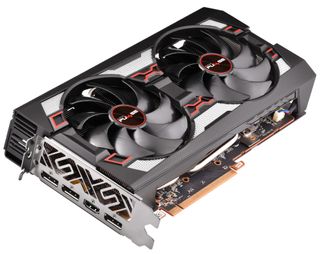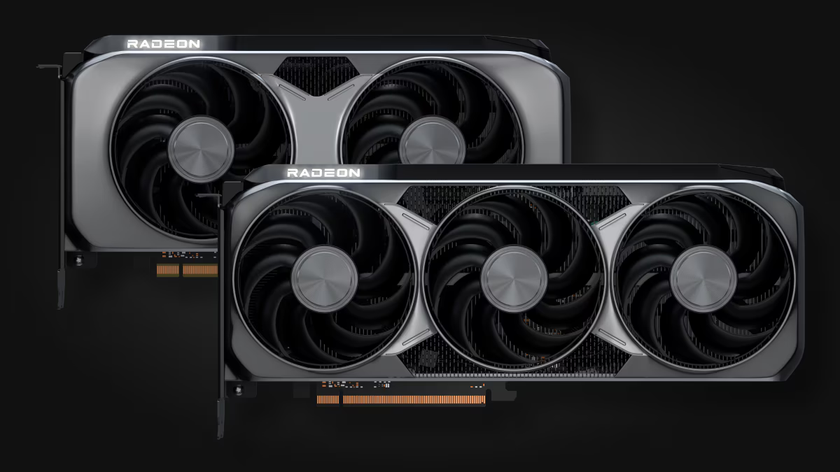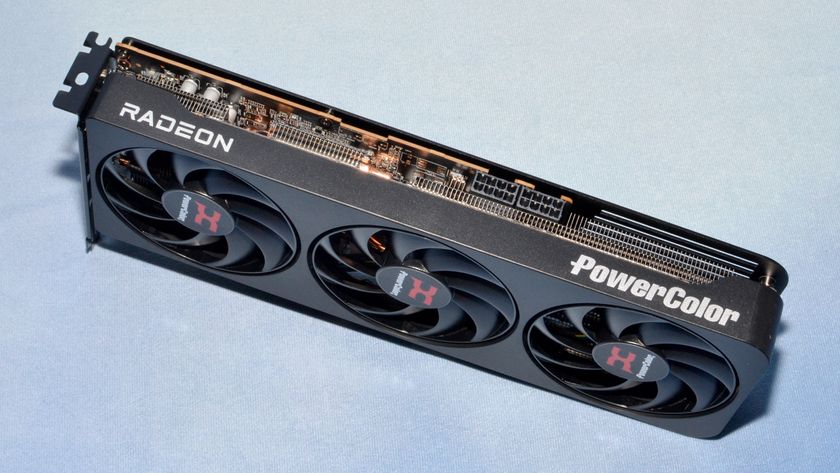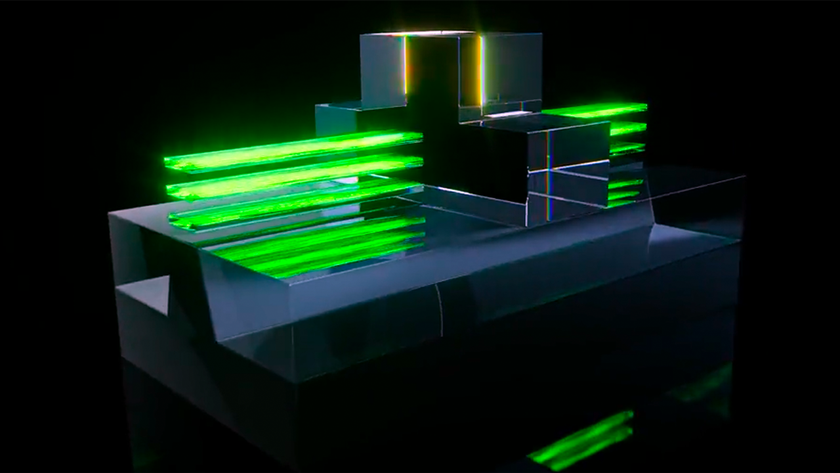
AMD has allegedly pushed out a new vBIOS to all its graphics cards partners to raise the performance on the its looming Radeon RX 5600 XT graphics card, Chinese news outlet HKEPC reported today. The move would likely be a response to Nvidia slashing the RTX 2060's price from $349 down to $299.
With the reported vBIOS, the RX 5600 XT looks like a different graphics card now. For starters, the vBIOS is said to increase the RX 5600 XT's TBP (typical board power) from 150W to 160W. The extra 10W should be enough headroom to bolster the graphics card's performance quite a bit.
Sapphire announced its Pulse Radeon RX 5600 XT just two days ago. However, it has since updated the card's specs. This leaves us wondering if Sapphire has already received AMD's vBIOS.




The Pulse Radeon RX 5600 XT originally featured a 1,560 MHz game clock and 1,620 MHz boost clock. Now, it's specced with a 1,615 MHz game clock and a boost clock up 1,750 MHz. That's a 3.5% and 8% improvement in the game and boost clocks, respectively.
Meanwhile, the specs have gone from listing the memory speed as 12 Gbps to it running at 14 Gbps. That's a 16.7% bump. The faster memory allows the graphics card to deliver a memory bandwidth up to 336 GBps, compared to the original 288 GBps figure.
Radeon RX 5600 XT Specifications
| Header Cell - Column 0 | Radeon RX 5700 | Pulse Radeon RX 5600 XT | Radeon RX 5600 XT |
|---|---|---|---|
| Architecture (GPU) | RDNA (Navi 10) | RDNA (Navi 10) | RDNA (Navi 10) |
| Shading Units | 2,304 | 2,304 | 2,304 |
| Texture Units | 144 | 144 | 144 |
| ROPs | 64 | 64 | 64 |
| Base Clock Rate | 1,465 MHz | ? | ? |
| Game Clock Rate | 1,625 MHz | 1,615 MHz | 1,375 MHz |
| Boost Clock Rate | 1,725 MHz | 1,750 MHz | 1,560 MHz |
| Memory Clock | 14 GBps | 14 GBps | 12 GBps |
| Memory Capacity | 8GB GDDR6 | 6GB GDDR6 | 6GB GDDR6 |
| Memory Bus | 256-bit | 192-bit | 192-bit |
| Memory Bandwidth | 448 GBps | 336 GBps | 288 GBps |
| L2 Cache | 4MB | 4MB | 4MB |
| TBP | 180W | 160W | 150W |
| Transistor Count | 10.3 billion | 251 mm² | 251 mm² |
| Die Size | 251 mm² | 251 mm² | 251 mm² |
| Price | $349 | ? | $279 |
The RX 5700 was already very close to the RX 5600 XT to start with. The RX 5700 had the slight upper-hand, thanks to its higher operating clocks and faster memory. But with these new reported specs, the RX 5600 XT would practically match the RX 5700, except for having 2GB less memory, reduced memory bus and lower TBP. It would seem that AMD essentially converted the RX 5600 XT into a RX 5700 6GB. Both graphics card utilize a variant of the Navi 10 die, so AMD is free to tweak the specifications as desired.
The RX 5600 XT's upgrade should give the graphics card a 10-15% performance boost. With these new enhancements, it'll be exciting to see if the RX 5600 XT gets within striking distance of the RTX 2060.
Stay On the Cutting Edge: Get the Tom's Hardware Newsletter
Get Tom's Hardware's best news and in-depth reviews, straight to your inbox.
Remember, the RX 5600 XT is expected to debut at $279, and despite the RTX 2060's recent price cut, AMD's offering is still $20 cheaper.

Zhiye Liu is a news editor and memory reviewer at Tom’s Hardware. Although he loves everything that’s hardware, he has a soft spot for CPUs, GPUs, and RAM.
-
tennis2 Just what we need. Another RX570/RX580 situation.... c'mon AMD, don't throw power efficiency out the window again.Reply -
King_V Maybe - I kind of wonder if calling this a 5700 LT or something might make more sense now.Reply
That said, it's one thing to up the clocks a little, it's another thing entirely for there to be faster VRAM... isn't it? 12Gbps vs 14Gbps isn't just a simple "up the clocks" situation from what I understand.
I wonder - did AMD understate what they had to keep Nvidia off-balance? -
joeblowsmynose Reply
150w to 160w ... 10w? ... 160w is typical for a midrange card, and is they same as the 2060 - which it seeks to compete with.tennis2 said:Just what we need. Another RX570/RX580 situation.... c'mon AMD, don't throw power efficiency out the window again.
So they gave consumers, more FPS, for free.
Since power consumption scales with fps potential on every line of cards ever made, I fail to see where the complaint is here ...
If they had gone from 220w to 250w to compete with a 160w rtx2060 - Then your complaint would make perfect sense. But that's not what happened. -
joeblowsmynose ReplyKing_V said:...
I wonder - did AMD understate what they had to keep Nvidia off-balance?
Probably. AMD seems to be playing this game with NVidia. Forcing NVidia to drop prices on every AMD launch, or launch a new line of "super" cards to try to compete, or whatever - its always something drastic ...
The best NVidia can do is lower prices as soon as they find out some info on an AMD launch which alleviates it a bit by "appearing" like it wasn't in response, because it is before the launches. (but we know better)
The longer AMD forces NVidia to have to constantly be adjusting their marketing / pricing and products to try to compensate for everything AMD does, the worse it will look, and begs the question how badly do they see AMD as threat? And how badly are the customers getting ripped off if NVidia is left to their intentions? These aspects end up being highlighted.
I don't think NVidia sees this yet, but the longer this will drag out the worse it will be for NVidia, just like the sentiment toward Intel these days, especially as AMD continues to put out more competitive cards.
I also think AMD is confident it will be able to compete in the very high end - and when NVidia has the more expensive product, doesn't have the performance crown or has to share it, has less bang for buck value - all these factors will start to create the sentiment that we see towards Intel currently.
I think this time next year will be quite interesting in the GPU space - NVidia definitely has more to innovate with than Intel has had in the last 4 years, so I think the GPU fight might get intense ... not yet though ... we'll see in a year's time. -
TJ Hooker Reply
I see this situation entirely differently. The fact that they are able to lower their prices means that they were enjoying months (a year in this case) of enhanced profit margins while they had no competition. And then when AMD finally manages to get something out to compete, all Nvidia has to do is lower MSRP and/or release a non-cutdown version of an existing GPU. And then within half a year Nvidia releases a new generation and gets to enjoy higher profit margins from lack of competition for another while. This has been going on for years, and I certainly wouldn't say it has been a drain on Nvidia, quite the opposite really.joeblowsmynose said:Probably. AMD seems to be playing this game with NVidia. Forcing NVidia to drop prices on every AMD launch, or launch a new line of "super" cards to try to compete, or whatever - its always something drastic ...
The best NVidia can do is lower prices as soon as they find out some info on an AMD launch which alleviates it a bit by "appearing" like it wasn't in response, because it is before the launches. (but we know better)
The longer AMD forces NVidia to have to constantly be adjusting their marketing / pricing and products to try to compensate for everything AMD does, the worse it will look, and begs the question how badly do they see AMD as threat? And how badly are the customers getting ripped off if NVidia is left to their intentions? These aspects end up being highlighted.
I don't think NVidia sees this yet, but the longer this will drag out the worse it will be for NVidia, just like the sentiment toward Intel these days, especially as AMD continues to put out more competitive cards.
I also think AMD is confident it will be able to compete in the very high end - and when NVidia has the more expensive product, doesn't have the performance crown or has to share it, has less bang for buck value - all these factors will start to create the sentiment that we see towards Intel currently.
I think this time next year will be quite interesting in the GPU space - NVidia definitely has more to innovate with than Intel has had in the last 4 years, so I think the GPU fight might get intense ... not yet though ... we'll see in a year's time.
Even if AMD manages to get a 2080 Ti competitor out Nvidia could just release an 2080 Ti Super with a fully enabled TU102 die. Or maybe Ampere will be out by that time, bringing a new level of performance and eliminating AMD's 7nm advantage. Either way, I see AMD continuing to be the one playing catch-up.
And it's not like reducing prices is a one way street. AMD does it all the time too, just look at what prices of RX 570/580s and Vegas did over the course of their lifespan as they faced increasing competition. Both companies often lower the price of the cards over time (either officially lower the MSRP or the retail prices just creep down), both in response to the other company or their own newer releases. If one drops their prices that isn't a win for the other. -
King_V I think @TJ Hooker and @joeblowsmynose were somewhat alluding to the same thing - that Nvidia, in doing these cuts, is sort of tacitly admitting that they were overcharging because they had no competition on a particular performance tier.Reply
Not that Nvidia couldn't afford the price cuts, but that they look bad because they COULD have charged less. -
TJ Hooker I don't know if I'd call it overcharging; they charged what the market will bear. They're a business whose goal is to make money, AMD would be doing the same thing if they could too.Reply
I hardly think dropping MSRP by $50 a year after the product came out makes them look bad, or will garner consumer resentment. As I said above, both AMD and Nvidia drop prices all the time for a variety of reasons. RX 580 8GB MSRP is $230 but can be bought right now for less than $170, does that mean AMD was previously ripping people off?
Also remember all the non-recurring engineering costs that go into designing a GPU. You have to recoup and make profit on that investment, it's not just a matter of looking at what it costs them for each GPU and how much they sell it for. -
King_V Oh, people get all kinds of resentment for all kinds of reasons, valid or not.Reply
I'm not too sure on previous gen stuff (500 series Polaris, Vega, and 10-series cards) because of how Crypto really threw things for a loop.
I would imagine, though, that most of the resentment would be from recent purchasers of the 2060 . . on the other hand, I'd be the guy that says "competition for it is coming out very soon, so WAIT, dude!"
Though, I imagine what the market will bear, what they can get away with, and overcharging are possibly a matter of semantics, with maybe overcharging being a bit strong of a term.
I guess it could be worse, though - I'm thinking of GTX 1080 prices up until the day the 1080Ti was released. -
joeblowsmynose ReplyTJ Hooker said:I see this situation entirely differently. The fact that they are able to lower their prices means that they were enjoying months (a year in this case) of enhanced profit margins while they had no competition. And then when AMD finally manages to get something out to compete, all Nvidia has to do is lower MSRP and/or release a non-cutdown version of an existing GPU. And then within half a year Nvidia releases a new generation and gets to enjoy higher profit margins from lack of competition for another while. This has been going on for years, and I certainly wouldn't say it has been a drain on Nvidia, quite the opposite really.
That was with Vega and Radeon7 - not many people even wanted those cards or could get them for their MSRP ... vega was priced completely out of any competitiveness with Nvidia because of the mining thing - there was no "bang for buck" with those AMD cards at all, so the environment and the effects were not the same as we are seeing with Navi.
Same reasoning as I presented above ... and of course old cards get lower prices. "Super" wasn't old - it was a brand new line in response to the 5700's launching, that cannibilzed their non-super line at lower prices; the 2060 is a bit older, but still not old. Again, I wouldn't put that in the same camp I described earlier.TJ Hooker said:And it's not like reducing prices is a one way street. AMD does it all the time too, just look at what prices of RX 570/580s and Vegas did over the course of their lifespan as they faced increasing competition. Both companies often lower the price of the cards over time (either officially lower the MSRP or the retail prices just creep down), both in response to the other company or their own newer releases. If one drops their prices that isn't a win for the other.
Intel became a victim of its own pricing, in the face of Ryzen ... 50% reduction on HEDT parts? What does that say to people who paid over a grand for 9980xe just last year?
Its about the mind sentiment that will build up over time ... just like what happened with Intel ... I can see AMD wanting to repeat that but in the GPU space. But like I said they'll need a performance crown (or to share it at least) and better prices / bang for buck together for that to properly happen .... I think AMD might stay committed to that model -- it does work, but takes time.










